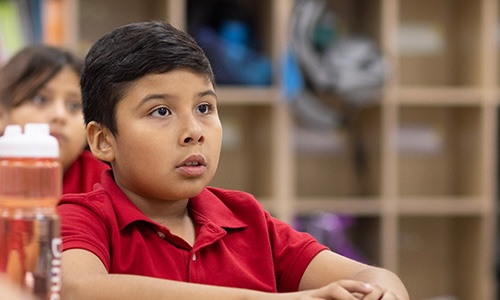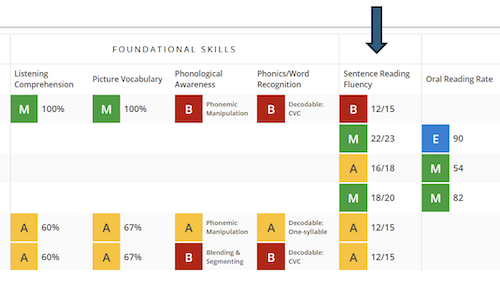 Azle Independent School District (ISD) in Azle, Texas, began their MAP® Reading Fluency™ journey with the best of intentions and a solid plan, two essential ingredients for success. But even the best-laid plans can quickly unravel, often at the worst possible moment.
Azle Independent School District (ISD) in Azle, Texas, began their MAP® Reading Fluency™ journey with the best of intentions and a solid plan, two essential ingredients for success. But even the best-laid plans can quickly unravel, often at the worst possible moment.
Azle’s educators kindly shared their MAP Reading Fluency story with us, and we’re sharing it with you because it’s one that’s worth hearing. You’ll likely find yourself smiling during a few “Are you kidding me? This is happening now?” type moments that we’ve all experienced. You’ll also see how they adapted to the situation, often in the moment. By sharing the story of their challenges, successes, and everything in between, the thoughtful and incredibly good-natured educators of Azle ISD hope other districts can learn from their trials, errors, and triumphs—and hopefully avoid the same pitfalls.
Why Azle made the shift
Azle ISD is located just west of Fort Worth, Texas, and serves over 7,200 students. The district’s demographics reflect a diverse and evolving community: approximately 65% white, not Hispanic; 30% Hispanic (of varying races); 51% economically disadvantaged; 10% emergent bilingual; and 15% special education students. With no dedicated data or assessment team, the curriculum and instruction (C&I) department is responsible for instructional decisions and data analysis.
Coming out of COVID school closures, Azle, like many districts, wanted to protect instructional time and ensure their assessments were meaningful. They were finding their existing tools—mCLASS (K–2) and DRA (K–6)—to be time consuming and inconsistent across grade levels. They were also trying to shift to using Lexile® scores. Meanwhile, MAP® Growth™ had gained traction and trust among educators at Azle, providing reliable insights and a great testing experience. So they made the leap to MAP Reading Fluency. The goals were clear:
- Provide consistent assessment across grades
- Reduce teacher bias
- Reclaim instructional time
- Deliver Lexile-based oral reading data
They began with a pilot in seventh-grade and one intermediate campus. The initial feedback was overwhelmingly positive: teachers appreciated the streamlined process and the quality of the data. But…
BOY (Big Ol’ Yikes!) struggles
The beginning of the school year brought a wave of unexpected challenges:
- Technical troubles. Azle’s tech team sourced $2 headphones to keep costs low. “We had headphones that didn’t work,” explains Sheri Welch, Azle’s director of Elementary Curriculum and Bilingual/ESL. They required adapters and, “Sometimes the adapters would work; sometimes they wouldn’t.” Teachers found themselves wearing their IT hats and were juggling devices, troubleshooting connections, and swapping out equipment mid-test. It was a frustrating start.
- Implementation missteps. In an effort to align MAP Reading Fluency with familiar systems, educators tried to fit it into old testing models. This led to overcomplicated test assignments and a lot of confusion around data reports. “We tried to take MAP Reading Fluency and fit it into our old way rather than embracing it for what it was,” says Sheri. This meant teachers had to follow a confusing flowchart to decide which tests students needed. “We made it harder on ourselves,” she admits.
- Teacher adjustment curve. The shift to MAP Reading Fluency required a new way of thinking about data. Teachers were used to mCLASS formats and DRA levels. Lexile scores and adaptive testing reports seemed foreign. Teachers made it clear they needed more support from leadership to be successful, says District Humanities Coordinator Julie Hall. “We ended up having to retroactively go back and do some Lexile training.”
MOY shuffle: Take 2!
Mid-year, Azle regrouped. They prioritized teacher feedback, revisited their implementation strategy, and made key adjustments:
- Better equipment. “We ordered some new, higher-quality headphones,” Sheri says. “We invested a little money there.” The district also trained teachers to check the connections at every point. This simple change reduced tech issues and improved the testing experience.
- Simplified testing. Azle got rid of their custom flowcharts and began assigning the adaptive test directly. “We just assigned the adaptive test as we should have from the start,” says Sheri. This streamlined the process and reduced confusion.
- Clearer data plans. The C&I team also developed clearer expectations around data interpretation. Instructional coaches received targeted training and became the bridge between district leadership and classroom teachers. “They are the conduit between the curriculum department and our campuses,” Sheri explains. “We really put a lot of time and energy into training them.”
Wins (and a few more challenges)
One campus emerged as a flagship, embracing the platform and leading by example. “Their kindergarten team is the one that grabbed onto the data. They built some effective ways to test their students more quickly and had more reliable data,” says Sheri. And their administrative team championed MAP Reading Fluency. “They reminded everybody of the ‘why’ and said, ‘We need to make sure this is working well. What do we need to do to get that done?’”
Still, challenges remained. Some recordings didn’t capture student responses accurately, for example, and teachers continued to wrestle with comparing beginning-of-year and middle-of-year data.
EOY: Third time’s the charm!
Azle found its rhythm by the end of the school year and saw meaningful results:
- Refined testing environment. One campus tested students in the cafeteria, spacing them out so headphones weren’t needed. Younger students used iPad microphones, which proved more reliable than external equipment. “I actually timed it,” says Julie. “From those kiddos coming in the door with their iPads to finishing the test and walking out, it was 35 minutes.”
- Efficiency and clarity. Teachers reported clearer data and improved perceptions of the assessment. The streamlined process allowed them to focus on instruction rather than logistics. “We had more students with clear reportings,” Julie says. “We had an improved teacher perception at that time.”
- The dream, realized: Data-driven instruction. The kindergarten team at the flagship campus used MAP Reading Fluency reports to plan tiered interventions. They created weekly routines based on foundational skill levels, targeting phonological awareness and phonics with precision. “They knew week to week what they were doing,” Julie says. “They knew what supports they needed to bring in, what resources to use.”
- The payoff. Azle saw significant Lexile growth and measurable student progress over the course of that first school year. “One of our campuses rose 215 Lexile points on average,” Jill shares. “Their kids were so proud.”
Lessons learned
Azle’s story provides solid advice for other districts considering MAP Reading Fluency:
- Train early and often. Lexile interpretation is key. Teachers need to understand what the data means and how to use it.
- Coordinate with technology teams. Don’t wait until mid-year to loop in IT. They’re essential partners.
- Pilot with champions. Choose enthusiastic teams for your pilot. This will allow you to troubleshoot in smaller ways, and success will inspire others. Educators from Azle’s pilot school presented at a district conference, and that helped the district bring other schools on board.
Future plans
Azle plans to expand progress monitoring, deepen its commitment to the science of reading, and implement curriculum changes. “We’re really leaning our district heart into science of reading,” says Jill. “What is research telling us? What is best for kids?”
They’re also exploring ways to better support upper-grade students who lack foundational skills. “We are getting more and more upper elementary and junior high kids who are missing those basic foundational skills,” she explains. “This lets us go back and say, ‘Is it a problem all the way back at phonics?’”
Final thoughts
Azle’s journey wasn’t perfect, but it was honest, reflective, and ultimately transformative. Looking a little deeper, it’s also clear Azle’s educators exemplify the district’s vision: “Every child will be future ready: not by chance, but by design.” We are so proud to partner with them.





